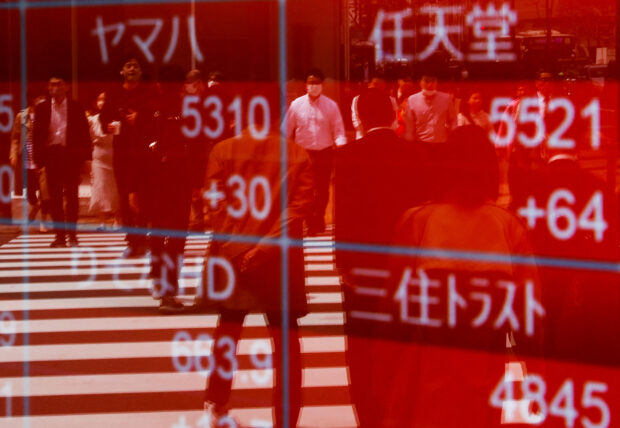
Passersby are reflected on an electric stock quotation board outside a brokerage in Tokyo, Japan April 18, 2023. REUTERS/Issei Kato/File photo
SYDNEY – Asian shares rallied for a fourth straight session on Monday after markets moved to price in earlier rate cuts in the United States and Europe, bullish wagers that will be tested by a swarm of central bank speakers this week.
Battered bond markets also enjoyed a welcome recovery as a benign U.S. payrolls report and upbeat productivity numbers suggested the labor market was cooling enough to obviate the need for further rate hikes from the Federal Reserve.
“This year’s better-than-expected U.S. supply-side performance raises hopes for a soft landing,” said Bruce Kasman, head of economic research at JPMorgan.
“By encouraging disinflation, strong productivity and labor supply gains might allow for job growth and low inflation to coexist,” he added. “This, in turn, would open the path for early Fed easing.”
Futures markets swung to imply a 90 percent chance the Fed was done hiking, and an 86 percent chance the first policy easing would come as soon as June.
Markets also imply around an 80 percent probability the European Central Bank will be cutting rates by April, while the Bank of England is seen easing in August.
READ: Bank of England keep rates at 15-year high, rules out quick cuts
Central bankers have their own chance to weigh in on this dovish outlook with at least nine Fed members speaking this week, including Chair Jerome Powell. Also on the docket are speakers from the Bank of Japan, BoE and ECB.
An odd man out is Australia’s central bank, which is considered likely to resume hiking rates at a policy meeting on Tuesday as inflation stays stubbornly high.
Elsewhere, hopes for lower borrowing costs helped MSCI’s broadest index of Asia-Pacific shares outside Japan gain 0.5 percent, having already rallied 2.8 percent last week and away from one-year lows.
Japan’s Nikkei rose 1.8 percent, after jumping 3.1 percent last week. S&P 500 futures and Nasdaq futures were both flat.
Bond relief
Two-year Treasury yields paused at 4.86 percent, after falling 17 basis points last week. Yields on 10-year notes stood at 4.59 percent, some way from October’s painful peak of 5.021 percent.
READ: U.S. 10-year Treasury yields hits 5% for first time since 2007
“Our view remains that rate cuts from the Fed, ECB and BoE will come a little sooner than is priced by markets and, in the initial phases, is likely to be bolder in terms of size,” wrote analysts at NatWest Markets in a note.
“We look for the Fed Funds rate to fall to 3-3.25 percent, the ECB depo rate to 3 percent and BoE Bank Rate to 4.25 percent by end-2024.”
The retreat in Treasury yields pulled the rug out from under the dollar, which was pinned at 105.110 having slid 1.3 percent last week to the lowest since late September.
The euro was firm at $1.0728, having surged 1 percent on Friday to its highest in two months. The dollar even lost ground to the ailing yen to stand at 149.46 and some way from its recent top of 151.74.
The drop in the dollar and yields helped underpin gold at $1,990, within striking distance of the recent five-month peak of $2,009.
Oil prices edged higher, after shedding 6 percent last week, drawing support from confirmation Saudi Arabia and Russia would continue their additional voluntary oil output cuts.
In the Middle East, Israel on Sunday rejected growing calls for a ceasefire in Gaza, with military specialists saying that forces are set to intensify their operations against Palestinian Islamist group Hamas.
Brent added 32 cents to $85.21 a barrel, while U.S. crude climbed 46 cents to $80.97 per barrel.